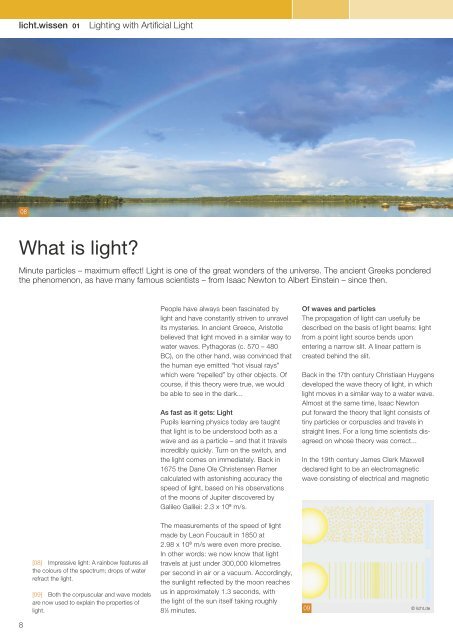licht.wissen No. 01 "Lighting with Artificial Light"
Booklet 1 is intended for all those who want to delve into the topic of light and lighting or wish to familiarize themselves with the basics of lighting technology. It also helps to make a decision in the field of lighting. Free Download at www.licht.de/en
Booklet 1 is intended for all those who want to delve into the topic of light and lighting or wish to familiarize themselves with the basics of lighting technology. It also helps to make a decision in the field of lighting. Free Download at www.licht.de/en
Create successful ePaper yourself
Turn your PDF publications into a flip-book with our unique Google optimized e-Paper software.
<strong>licht</strong>.<strong>wissen</strong> <strong>01</strong><br />
<strong>Lighting</strong> <strong>with</strong> <strong>Artificial</strong> Light<br />
08<br />
What is light?<br />
Minute particles – maximum effect! Light is one of the great wonders of the universe. The ancient Greeks pondered<br />
the phenomenon, as have many famous scientists – from Isaac Newton to Albert Einstein – since then.<br />
People have always been fascinated by<br />
light and have constantly striven to unravel<br />
its mysteries. In ancient Greece, Aristotle<br />
believed that light moved in a similar way to<br />
water waves. Pythagoras (c. 570 – 480<br />
BC), on the other hand, was convinced that<br />
the human eye emitted “hot visual rays”<br />
which were “repelled” by other objects. Of<br />
course, if this theory were true, we would<br />
be able to see in the dark...<br />
As fast as it gets: Light<br />
Pupils learning physics today are taught<br />
that light is to be understood both as a<br />
wave and as a particle – and that it travels<br />
incredibly quickly. Turn on the switch, and<br />
the light comes on immediately. Back in<br />
1675 the Dane Ole Christensen Rømer<br />
calculated <strong>with</strong> astonishing accuracy the<br />
speed of light, based on his observations<br />
of the moons of Jupiter discovered by<br />
Galileo Galilei: 2.3 x 10 8 m/s.<br />
Of waves and particles<br />
The propagation of light can usefully be<br />
described on the basis of light beams: light<br />
from a point light source bends upon<br />
entering a narrow slit. A linear pattern is<br />
created behind the slit.<br />
Back in the 17th century Christiaan Huygens<br />
developed the wave theory of light, in which<br />
light moves in a similar way to a water wave.<br />
Almost at the same time, Isaac Newton<br />
put forward the theory that light consists of<br />
tiny particles or corpuscles and travels in<br />
straight lines. For a long time scientists disagreed<br />
on whose theory was correct...<br />
In the 19th century James Clerk Maxwell<br />
declared light to be an electromagnetic<br />
wave consisting of electrical and magnetic<br />
[08] Impressive light: A rainbow features all<br />
the colours of the spectrum; drops of water<br />
refract the light.<br />
[09] Both the corpuscular and wave models<br />
are now used to explain the properties of<br />
light.<br />
The measurements of the speed of light<br />
made by Leon Foucault in 1850 at<br />
2.98 x 10 8 m/s were even more precise.<br />
In other words: we now know that light<br />
travels at just under 300,000 kilometres<br />
per second in air or a vacuum. Accordingly,<br />
the sunlight reflected by the moon reaches<br />
us in approximately 1.3 seconds, <strong>with</strong><br />
the light of the sun itself taking roughly<br />
8 1 ⁄3 minutes.<br />
09<br />
© <strong>licht</strong>.de<br />
8

















